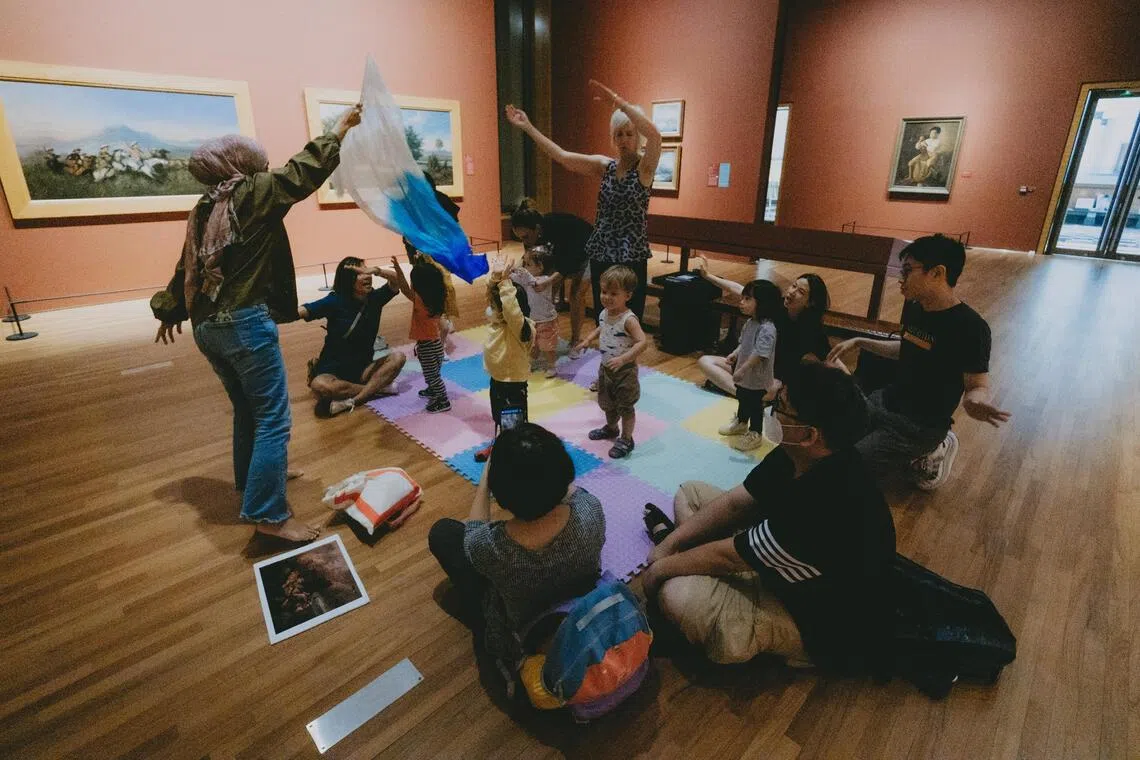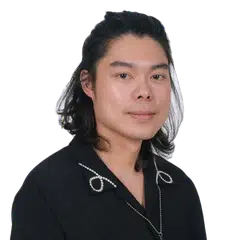Free entry, Milo and pop-up market: National Gallery Singapore’s 10th birthday wish is art for all
Sign up now: Get ST's newsletters delivered to your inbox

NGS' GalleryToddlers! encourages children to engage with art.
PHOTO: NATIONAL GALLERY SINGAPORE
Follow topic:
SINGAPORE – The National Gallery Singapore (NGS) celebrates its 10th birthday with a weekend bash on Nov 15 and 16. Closing time will be extended from 7 to 10pm, with all-day crowd-pleasing draws including a rave and a pop-up market of local brands.
The $532 million gallery housed in the restored buildings of the former Supreme Court and City Hall is marking its first decade of welcoming more than 14 million visitors since opening to much fanfare on Nov 24, 2015.
Exhibitions will be open to the public for free, including the highly anticipated blockbuster show Into The Modern: Impressionism From The Museum Of Fine Arts, Boston. The year-end anchor, which opens on Nov 14, has brought in works never before exhibited in Singapore by beloved French painters including Claude Monet, Paul Cezanne and Edgar Degas.
There will be an Old Chang Kee mobile food truck, a Milo van, tutu kueh and ice cream. Brands such as Singapore’s first home-grown sunglasses brand Rocket Eyewear, jewellery label Curious Creatures, craft company Bynd Artisan, design brand Supermama, camera manufacturer Leica and fashion studio Ans.Ein will have bespoke merchandise reimagining NGS’ spirit and identity on sale.
Since a delayed opening plagued by construction hold-ups and high-level staffing issues in 2015, NGS has established itself at the centre of the visual arts ecosystem in the country, becoming Asia’s seventh most-visited museum, drawing two million visitors in 2024.
By the numbers, NGS has presented some 70 exhibitions, and grown its staff and curators by 85 per cent since 2015. It has also procured over 2,000 works of art in the intervening years to boast 9,000 works in its collection, holding the keys to the largest public collection of South-east Asian art in the world today.
Its chief executive Eugene Tan says NGS remains committed to Singapore and South-east Asian art in an increasingly crowded Asian art landscape.
While tapping continued worldwide interest in the histories and art of the Global South and those outside the Eurocentric frame, it will also continue to make sure its efforts and research find the general public.
Dr Tan adds: “One thing that has not changed since our opening is our belief that art is for everyone. People remain at the heart of what we do, and we continue to create an inclusive and welcoming museum environment.”
Then-Prime Minister Lee Hsien Loong, during his inauguration speech for NGS, laid down the gauntlet: “The measure of success is not how many tourists come, or how our museum ranks internationally, but whether Singaporeans feel that the gallery belongs to them.”
Dr Tan, who was appointed NGS director as early as 2013, says: “And as we continue to innovate, one guiding principle remains: technology and change must always serve the art and the people engaging with it.”
The weekend celebrations stem from this philosophy, as well as recent high-profile outreach efforts such as that with South Korean boy band BTS’ Jin,
Also on the party programme are a matcha lounge with curated DJ sets redefining South-east Asian sound and an adult-only rave with immersive installations at night. Those keen to take control of the playlist can co-create the gallery birthday mixtape on Spotify, which will be played across public spaces throughout the weekend.
Dr Tan cites the Covid-19 pandemic as a defining experience for the gallery, not just accelerating NGS’ take-up of hybrid and immersive experiences, but also growing its offerings that pitch art as a tool for wellness and emotional support.
“It fundamentally changed how people experience culture,” he says, adding that NGS has also intentionally included lesser-known voices and perspectives, such as those of women artists and minority communities.
NGS at its opening declared a bold target of five million visitors a year, but Dr Tan prefers more sustained meaningful growth rather than hitting a single number. “We don’t have the ultimate visitorship figure,” he says. “We set annual targets based on the previous year’s achievements and broader sector trends.”
Chief curator Patrick Flores says the opening of NGS marked a “significant turn” for the region with an art institution dedicated to telling its stories. The gallery, as the leading regional visual arts museum, is committed to global dialogue that transcends borders.
He cites NGS’ 2023 Tropical: Stories From South-east Asia And Latin America City Of Others: Asian Artists In Paris, 1920s-1940s
He is also the project director of the ongoing Fernando Zobel: Order Is Essential, which showcases the oeuvre of the Philippines-born transcontinental artist, straddling South-east Asian, Chinese and Western modernisms.
He says: “I’d like to see more exhibitions that connect histories across regions and time – exhibitions that not only sharply profile art, but also reveal how artists in South-east Asia have shaped the world’s visual imagination.”
NGS has over the years also gleaned the importance of collaborating with non-Singapore museums, he adds. It took an exhibition of Singapore artist Georgette Chen to He Xiang Ning Art Museum in China in 2025, and has found willing partners in institutions like the Centre Pompidou in France and the Staatliche Kunstsammlungen Dresden in Germany.
“(This) has not only strengthened Singapore’s profile as a cultural contact zone, but also enriched the experience for local audiences,” he says. “As we step into the next decade, we will continue to re-imagine South-east Asia’s place in the world, and the world through South-east Asia.”


